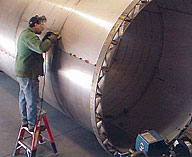
The steel market was affected by a variety of factors. In December 2003, President Bush repealed tariffs on imported steel. Mill consolidations and a booming economy in China limited supplies. A shortage of coke, a necessary material for steel production, and a shortage of scrap metal, also used for steel production, contributed to the limited steel supply.
The shortage caused steel prices to skyrocket, creating an industry-wide chain reaction. Higher prices were passed down to contractors, who in turn were forced to decide whether to pass the costs on to customers.

Some associations took action. SMACNA, along with its alliance partners the National Electrical Contractors Association (NECA) and the Mechanical Contractors Association of America (MCAA), worked to get congressional and administrative attention on the issue.

Economists predict the soaring price of steel will gradually come back down, but it's expected to be a long, slow decline. At the National Association of Home Builders (NAHB) Construction Forecast Conference, an economist predicted that price levels at the end of next year are still going to be comparatively high.
Publication date: 12/27/2004

Report Abusive Comment